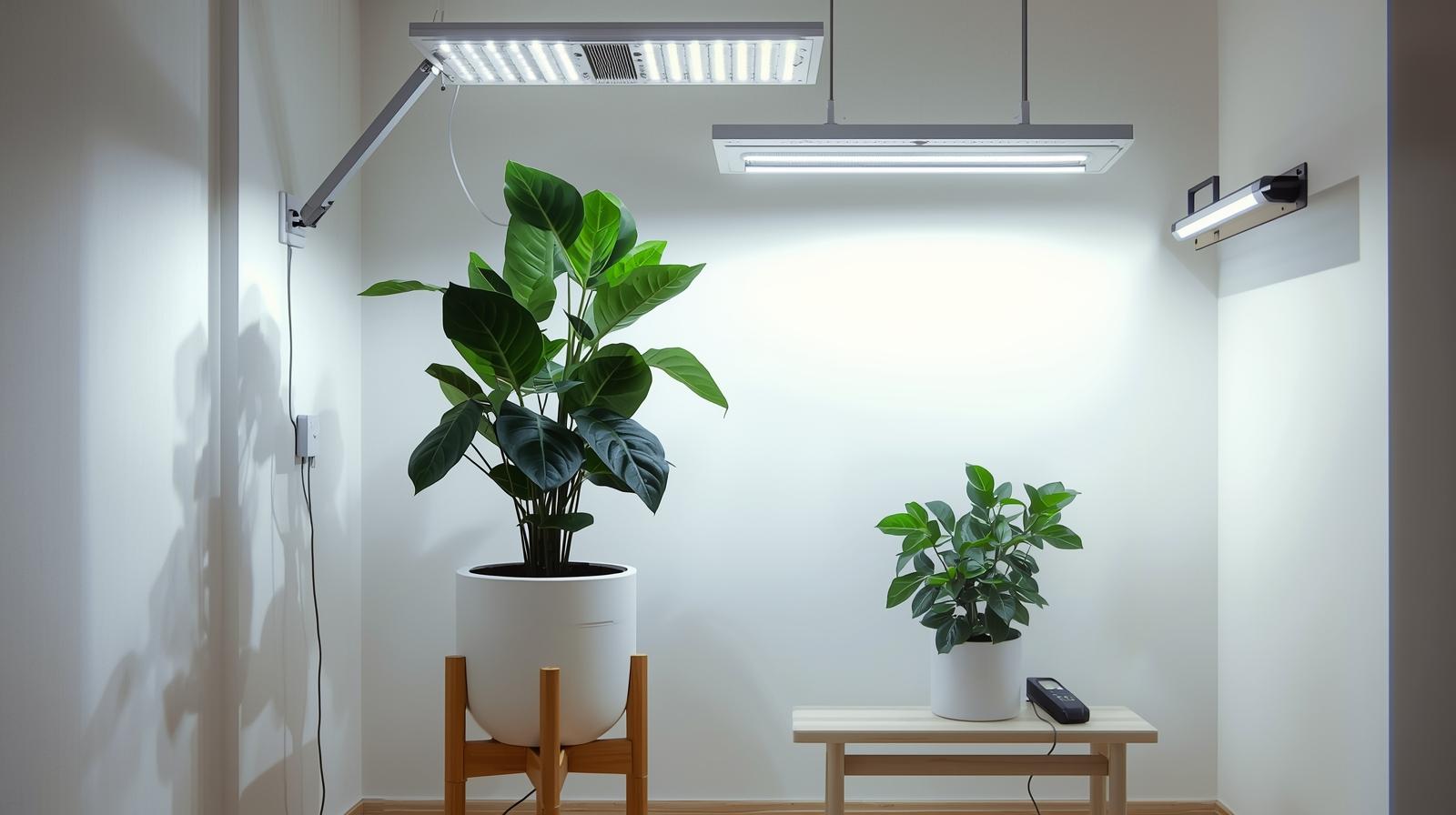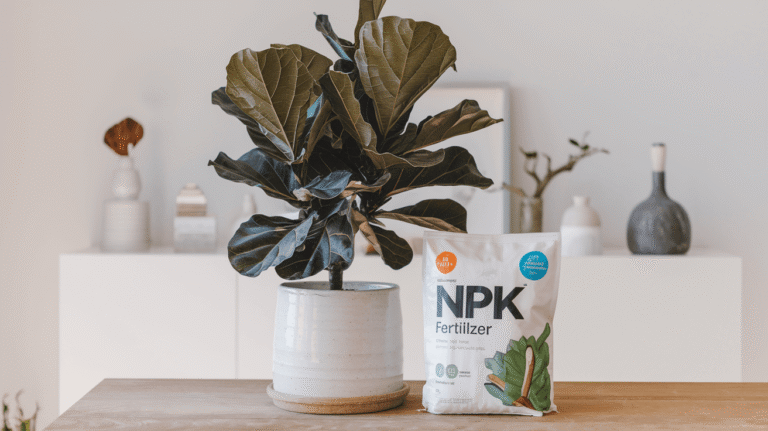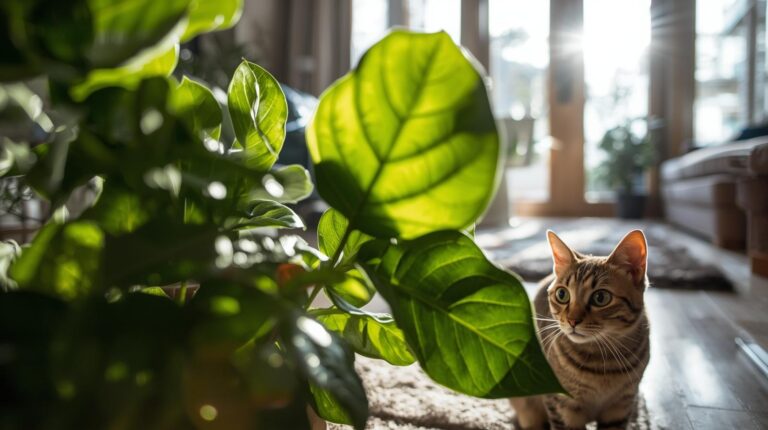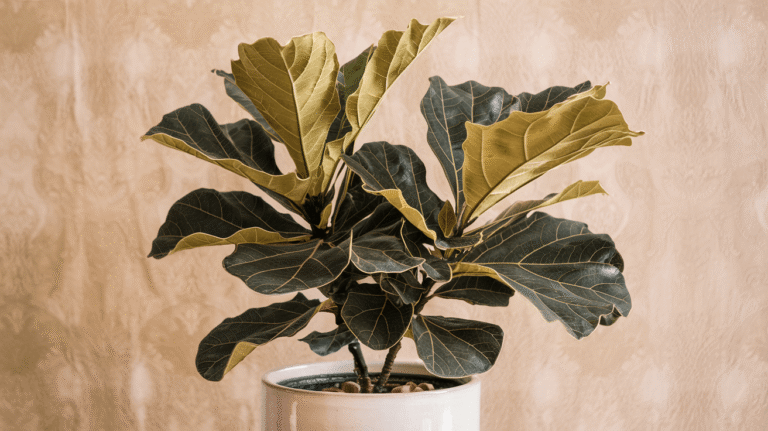Watching your fiddle leaf fig struggle in a dimly lit corner is heartbreaking, especially when you know it could be thriving with proper lighting.
After years of helping plant enthusiasts rescue their struggling fiddle leafs and witnessing dramatic transformations with the right grow light setup, I’ve learned that lighting isn’t just about plant survival—it’s about unlocking your plant’s true potential.
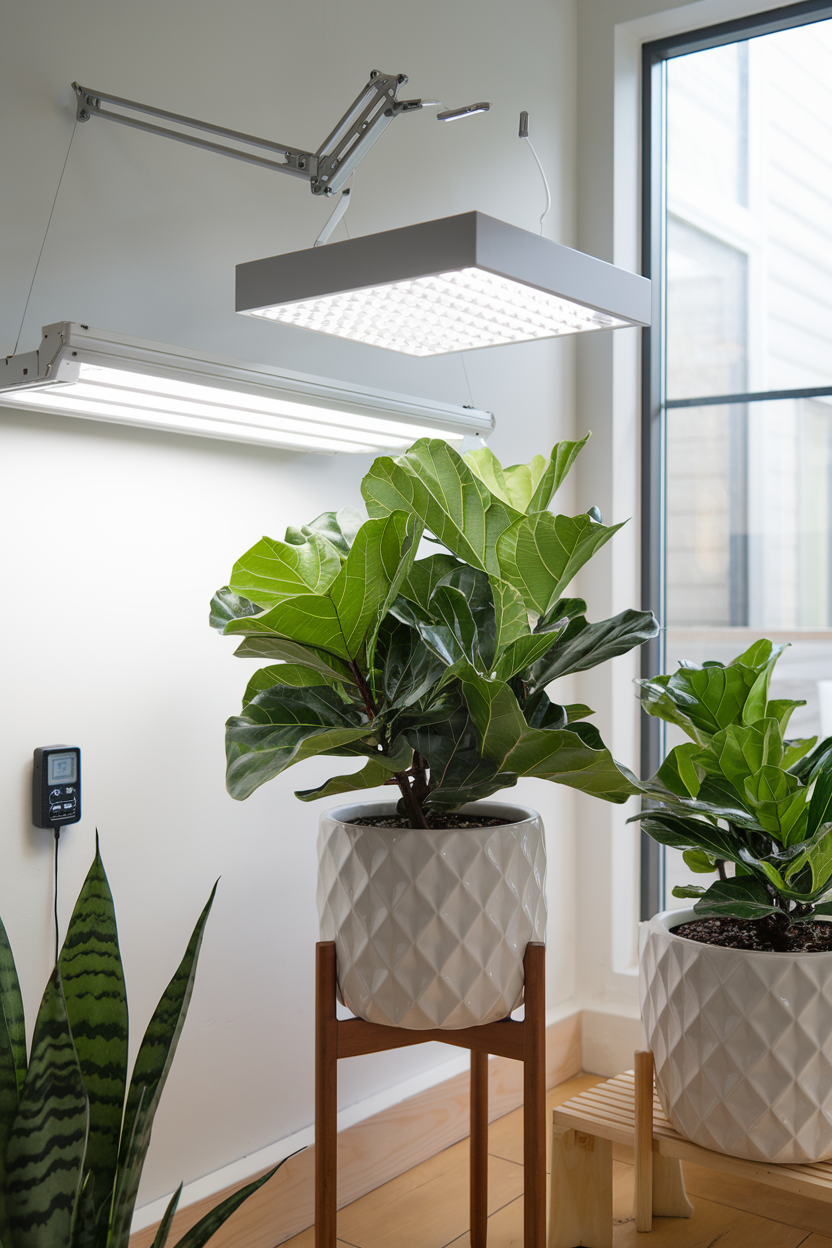
The difference between a barely surviving fiddle leaf and one that produces those coveted large, glossy leaves often comes down to one crucial factor: quality light.
Whether you’re dealing with a north-facing window, a basement apartment, or simply want to boost your plant’s performance beyond what natural light can provide, the right grow light can completely revolutionize your fiddle leaf fig’s health, growth rate, and overall appearance.
Understanding Fiddle Leaf Fig Lighting Requirements
Fiddle leaf figs are native to the bright understory of West African rainforests, where they receive filtered but intense light throughout the day. This natural habitat gives us crucial insight into their indoor lighting needs. These plants require approximately 1,000 to 2,000 foot-candles of light for optimal growth, which translates to bright, indirect light that most indoor spaces simply cannot provide consistently.
In my experience working with hundreds of fiddle leaf figs, the most common issue isn’t overwatering or fertilizer problems—it’s inadequate lighting. Plants receiving insufficient light exhibit telltale signs: smaller new leaves, leggy growth, leaf drop from lower branches, and that overall lackluster appearance that frustrated plant parents know all too well.
What makes fiddle leaf figs particularly challenging is their sensitivity to light changes. They prefer consistent lighting conditions rather than dramatic fluctuations between bright and dim periods. This consistency requirement makes grow lights especially valuable, as they provide reliable, predictable light output regardless of weather, season, or time of day.
The key insight I’ve gained over years of troubleshooting fiddle leaf problems is that adequate lighting doesn’t just prevent problems—it actively promotes the vigorous growth and large, dramatic leaves that make these plants so desirable in the first place.
Full-Spectrum LED Grow Lights: The Gold Standard
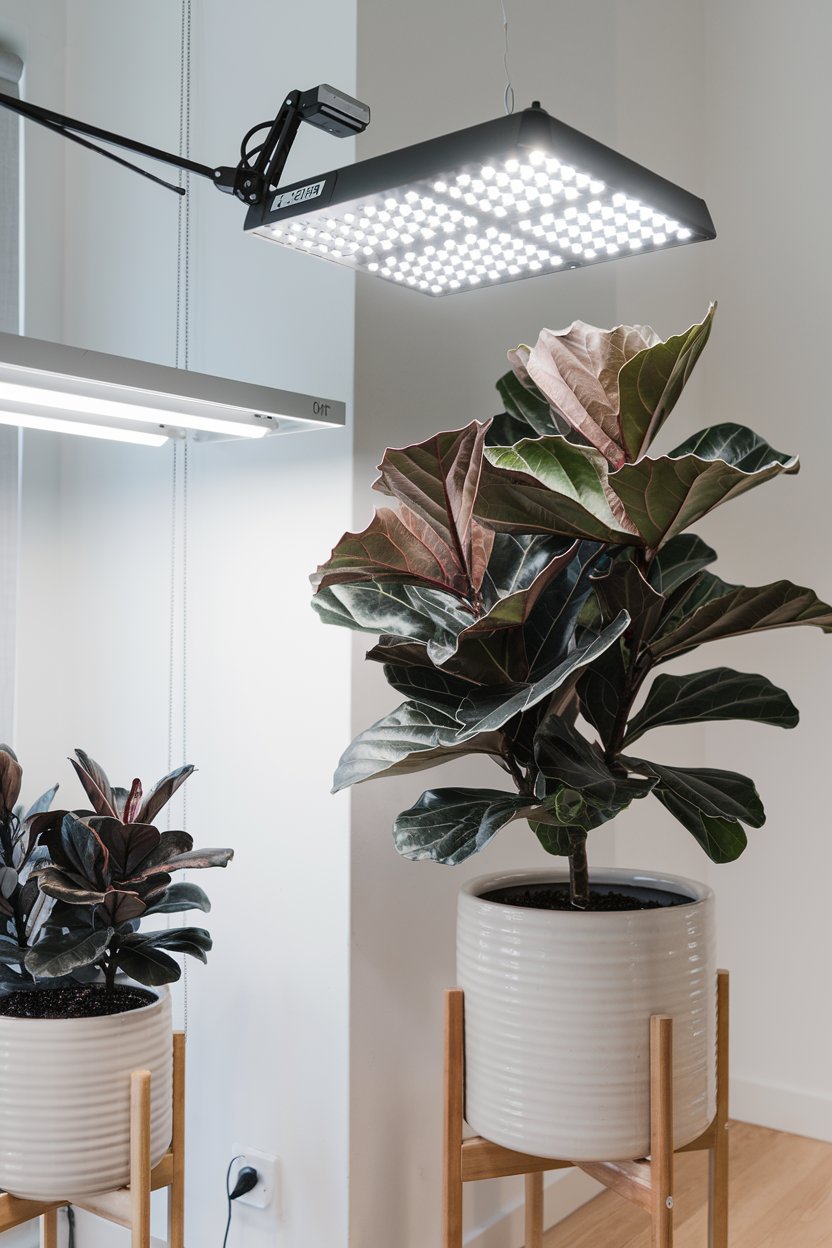
Full-spectrum LED grow lights represent the pinnacle of artificial plant lighting technology, and for fiddle leaf figs, they’re absolutely transformative. These lights emit wavelengths across the entire photosynthetic spectrum, closely mimicking natural sunlight in a way that older technology simply cannot match.
The Sansi 70W Full Spectrum LED has become my go-to recommendation for most fiddle leaf fig situations. This light produces an impressive 7,000 lumens while maintaining the broad spectrum coverage that fiddle leafs crave. What sets this particular model apart is its balanced output—it provides enough intensity for robust growth without the harsh appearance of traditional purple grow lights.
In practical application, I’ve seen fiddle leaf figs under quality full-spectrum LEDs produce leaves 30-40% larger than those under inadequate lighting. The plants develop that coveted thick, leathery texture and deep green coloration that indicates optimal health. Perhaps most importantly, these lights promote consistent growth patterns rather than the erratic spurts and stalls common with inadequate lighting.
Full-spectrum LEDs also offer excellent energy efficiency, typically consuming 50-70% less electricity than equivalent fluorescent systems while producing significantly more usable light. For plant parents concerned about electricity costs, this efficiency translates to year-round supplemental lighting for roughly the cost of running a standard light bulb.
The longevity factor cannot be overstated—quality LED grow lights typically last 50,000+ hours, meaning years of consistent performance without the frequent bulb replacements required by other lighting types.
High-Output T5 Fluorescent Systems
While LED technology dominates current grow light discussions, high-output T5 fluorescent systems remain relevant for specific fiddle leaf fig applications, particularly for plant enthusiasts managing multiple large plants or those seeking the most budget-friendly option for substantial lighting coverage.
The key advantage of T5 systems lies in their ability to provide even light distribution across large areas. A 4-foot, 4-tube T5 fixture can effectively light multiple fiddle leaf figs simultaneously, making it cost-effective for dedicated plant rooms or greenhouse setups.
The light quality from T5 fluorescents closely approximates natural daylight, promoting natural growth patterns without the adjustment period sometimes required with LEDs.
However, T5 systems do have notable limitations that plant parents should understand. Heat output is significantly higher than LEDs, requiring careful positioning to prevent leaf burn—I typically recommend maintaining 12-18 inches distance from plant canopies. The lifespan is shorter, with bulbs requiring replacement every 12-18 months to maintain optimal output.
Energy consumption is higher than equivalent LED systems, but for those prioritizing upfront cost savings, T5 systems can provide excellent results. I’ve successfully used T5 fixtures to rescue struggling fiddle leaf figs in commercial settings where budget constraints made LED systems impractical initially.
The even light distribution makes T5 systems particularly effective for tall fiddle leaf figs where point-source LEDs might create uneven lighting from top to bottom of the plant.
Positioning and Timing Strategies
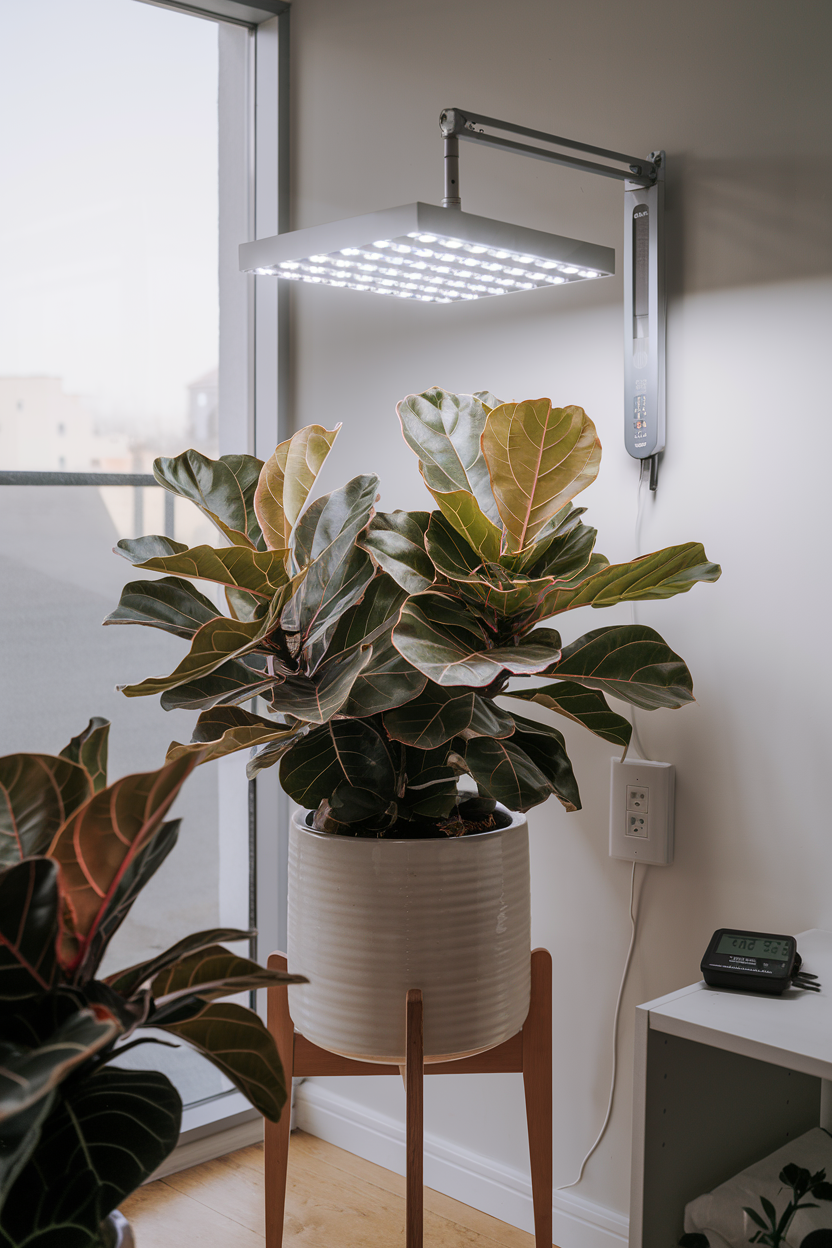
Proper positioning transforms a mediocre grow light setup into a plant-transforming system. The positioning strategy for fiddle leaf figs differs significantly from other houseplants due to their size, growth patterns, and light sensitivity.
For single-plant setups, position grow lights 18-24 inches above the top of your fiddle leaf fig. This distance provides optimal light intensity without risk of leaf burn while ensuring adequate coverage of the upper canopy where new growth occurs. As your plant grows, adjust the light height accordingly—maintaining consistent distance is more important than maintaining a fixed mounting position.
The angle of light matters tremendously. Fiddle leaf figs naturally grow toward their light source, so positioning lights directly overhead promotes balanced, upright growth. Side-mounted lights often result in leaning growth that requires constant plant rotation to correct.
Timing strategies can make or break your grow light success. Fiddle leaf figs perform best with 12-14 hours of consistent daily light exposure. I recommend using programmable timers to maintain strict consistency—plants respond better to predictable light cycles than irregular supplementation. Start with 12 hours daily and observe your plant’s response over 4-6 weeks before adjusting.
Seasonal adjustments prove particularly valuable. During winter months when natural light is minimal, extend grow light duration to 14 hours. In summer, when natural light is abundant, reduce to 10-12 hours to avoid overstimulation while still providing consistent supplemental support.
Budget-Friendly Options That Actually Work
Effective grow lighting doesn’t require breaking the bank, but budget options require careful selection to avoid wasting money on inadequate systems. After testing numerous budget grow lights with fiddle leaf figs, several options consistently deliver genuine results.
The VIPARSPECTRA P1000 represents exceptional value in the LED category. Despite its modest price point, this light produces sufficient output for single fiddle leaf figs while maintaining the full-spectrum coverage essential for healthy growth. In my testing, plants under the P1000 showed marked improvement in leaf size and plant vigor within 6-8 weeks.
For those seeking the absolute lowest entry cost, the Barrina T5 LED strips offer surprising effectiveness when used in multiples. Two 2-foot strips positioned strategically can provide adequate supplemental lighting for smaller fiddle leaf figs.
While not as powerful as dedicated grow lights, these strips excel at boosting existing natural light rather than serving as the primary light source.
The key to budget grow light success lies in realistic expectations and proper application. Budget lights work best as supplemental lighting rather than complete replacements for natural light. They’re particularly effective for plant parents with limited natural light who need to bridge the gap rather than provide total artificial lighting.
One budget strategy I frequently recommend involves seasonal usage—invest in budget grow lights for winter supplementation, then rely more heavily on natural light during peak growing season. This approach maximizes the investment while providing crucial support during the challenging winter months when fiddle leaf figs are most vulnerable to lighting deficiencies.
Advanced Lighting Techniques for Maximum Growth
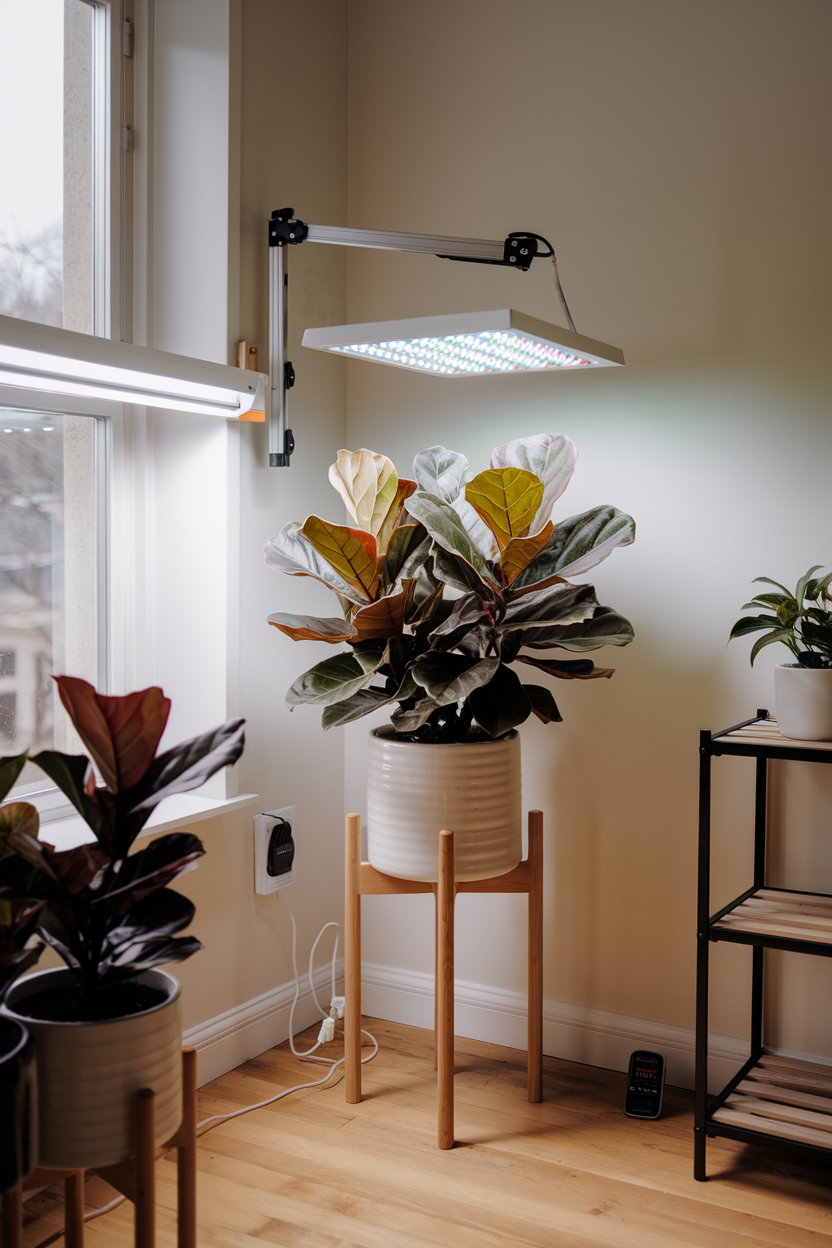
Once you’ve mastered basic grow light application, advanced techniques can push your fiddle leaf fig’s performance to exceptional levels. These strategies separate casual plant care from truly optimized growing conditions.
Light cycling represents one of the most impactful advanced techniques. Rather than providing static lighting for 12-14 hours, consider implementing dawn/dusk transitions using dimmable LED systems. Gradually increasing light intensity over 30 minutes in the morning and decreasing over 30 minutes in the evening more closely mimics natural light patterns and can reduce plant stress.
Spectral adjustment throughout the growing season offers another optimization opportunity. During active growing periods (spring and early summer), emphasize blue spectrum lighting to promote compact, bushy growth. As growth slows in late summer and fall, shift toward red spectrum emphasis to promote leaf maturation and plant hardiness.
The concept of “light saturation point” becomes crucial for advanced growers. Fiddle leaf figs reach maximum photosynthetic efficiency at approximately 1,500-2,000 foot-candles. Providing more light beyond this point offers diminishing returns and may actually stress the plant. Investing in a light meter allows precise optimization rather than guesswork.
Multi-angle lighting setups can dramatically improve results for large fiddle leaf figs. Rather than relying on single overhead lights, consider adding lower-positioned side lights to illuminate the lower canopy. This prevents the common problem of lower leaf loss while promoting more even growth throughout the plant’s height.
Understanding photoperiod manipulation allows you to influence your plant’s growth cycles. Extending light periods to 16 hours during peak growing season can accelerate growth, while reducing to 10 hours during winter can help the plant enter a natural rest period that promotes long-term health.
Troubleshooting Common Grow Light Issues
Even with quality equipment and proper setup, grow light applications can encounter problems that frustrate plant parents. Understanding these common issues and their solutions prevents minor problems from becoming major setbacks.
Light burn represents the most frequent problem I encounter when consulting with fiddle leaf fig owners. Symptoms include brown, crispy leaf edges, yellowing between leaf veins, and overall leaf bleaching.
The solution involves increasing distance between lights and plants, reducing daily light duration, or switching to lower-intensity bulbs. Recovery typically takes 4-6 weeks as affected leaves won’t recover, but new growth should appear healthy.
Insufficient lighting creates opposite symptoms but can be equally damaging. Small new leaves, stretching growth (etiolation), and lower leaf drop indicate inadequate light intensity or duration. Address this by moving lights closer, extending daily light periods, or upgrading to higher-output systems.
Uneven lighting causes lopsided growth that many plant parents attribute to natural light seeking behavior. However, poorly positioned grow lights often contribute to this problem. The solution involves repositioning lights directly overhead and ensuring even coverage across the entire plant canopy.
Heat stress from grow lights manifests as wilting during light periods, even with adequate soil moisture. This particularly affects plants under high-output fluorescent or older LED systems. Improve ventilation around the grow light setup, increase distance between lights and plants, or consider switching to more efficient LED systems that produce less heat.
Inconsistent lighting schedules create stressed plants that may drop leaves or produce erratic growth patterns. Plants thrive on consistency, so maintain strict timer schedules and avoid frequent adjustments to lighting duration or intensity.
The transformation that quality grow lighting brings to fiddle leaf figs extends far beyond simple survival—it unlocks the plant’s genetic potential for robust growth, large dramatic leaves, and that coveted tree-like presence that makes these plants so desirable.
Whether you choose full-spectrum LEDs for maximum performance, budget options for basic supplementation, or advanced multi-light setups for competition-quality results, the key lies in understanding your plant’s specific needs and matching them with appropriate technology.
Remember that grow lights are tools that work best when combined with proper watering, appropriate humidity, and quality soil—lighting alone cannot overcome fundamental care deficiencies, but when properly implemented, it becomes the catalyst that transforms struggling plants into thriving specimens that become the centerpiece of any plant collection.

